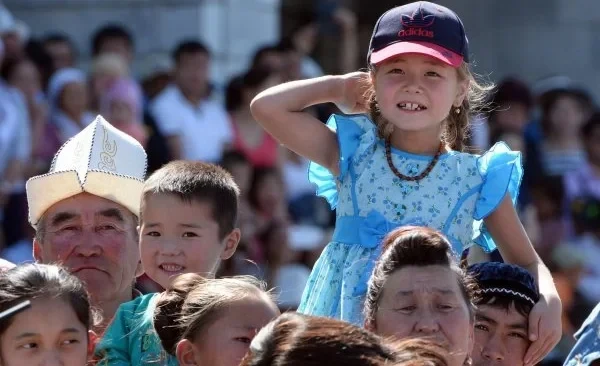Weather conditions in Kyrgyzstan on October 24. According to data from Kyrgyzhydromet, clear...

Population of Kyrgyzstan from 1917 to 1970...
Weather forecast for Kyrgyzstan on October 21. According to Kyrgyzhydromet, no precipitation is...
The weather in Kyrgyzstan on October 23. According to the data from Kyrgyzhydromet, rain is...
Weather forecast for Kyrgyzstan on October 22. According to information from Kyrgyzhydromet, no...

Territory, Geography, and Administrative Division of the Kyrgyz Republic The Kyrgyz Republic...

Population of Kyrgyzstan Thanks to the fundamental changes that occurred in Kyrgyzstan after the...

According to various estimates, between 500,000 and 800,000 people have left Kyrgyzstan since...

The Osh Region was established on November 21, 1939, replacing the former district. After numerous...

Population of Kyrgyzstan since the beginning of independence After the collapse of the Soviet...

The Batken Region was established on October 12, 1999, from the Osh Region. It includes the...

Census of the Kyrgyz SSR in 1959 - 1970 - 1979 - 1989. According to the 1959 census, the...

The First General Census of the Population of the Russian Empire 1897 At the time of the First...

The Earth's Population This is the total number of people living on our planet. As of today,...

The trend for new state license plates has surpassed the recent trend of turbocharged cars. The...

Population of Kyrgyzstan in 2019 In 2019, the population of Kyrgyzstan will increase by 104,931...

Kyrgyzstan is experiencing a rapid increase in population. This was stated by specialists from the...

The diversity of wildlife in Kyrgyzstan contributes to the development of foreign hunting tourism...

During the period under consideration, the Kyrgyz population occupied approximately the same part...

The Population of Kyrgyzstan in the 19th - Early 20th Century Most of the country's territory...

As of September 1, 2025, the permanent population of the Kyrgyz Republic reached 7 million 361...

The Chuy Region was established on December 14, 1990. Until 1939, various...

National Statistical Committee: Female Population Predominates in Cities of Kyrgyzstan, While Male...

Memorial House-Museum of Ishak Razzakov This museum complex was established not long ago, on...

KYRGYZSTAN. Kyrgyz Republic A country in the northeast of Central Asia. Located within the...

Kara-Kul is a city in the Jalal-Abad region of Kyrgyzstan. According to the 2009 census of...

As of January 1, 2013, the territory of the Kyrgyz Republic, according to the State Registration...

What will the weather be like in Kyrgyzstan in October? It is expected that the month will be...
Bishkek (Kyrgyz: Бишкек) is the capital of Kyrgyzstan and the largest city in the country. It...

According to the census data, significant changes occurred in the distribution of the employed...

Population in the Kirghiz ASSR from 1926 to 1939 The period from 1926 to 1936 was characterized by...

Weather in Kyrgyzstan for August Kyrgyzhydromet has prepared a preliminary weather forecast for...

Ghana. Republic of Ghana A country in the western part of Africa. It borders Burkina Faso to the...

President of the Kyrgyz Republic Almazbek Atambaev met today, November 26, with the Prime Minister...

BAZARKORGON AND BAZARKORGON DISTRICT Bazarkorgon (Kyrgyz: Базар-Коргон) is a village in the...

The Kyrgyzstan Youth Boxing Championship has concluded in Osh. This was reported by the federation...

The Jalal-Abad Region was established on November 21, 1939. From January 27, 1959, it became part...

Benin. Republic of Benin The Republic of Benin (formerly Dahomey until 1975) is located in West...

Sulyukta is a city of regional subordination in the Batken region of Kyrgyzstan. Population (2009)...

Historical information about the size of the multi-ethnic population of the Fergana Valley during...

By 2050, the population of Central Asia will reach 96 million people. This represents an increase...

The Naryn Region is located in the southeast of Kyrgyzstan and was first established on November...

The city of Kerben is located in the center of the Aksy district, at an altitude of 1200 meters...

Kyrgyz Inhabitants of the Irtysh and Altai Regions? In this case, the area of "Kyrgyz"...

Categories of Protected Natural Areas in Kyrgyzstan Kyrgyzstan has established 83 special...

Administrative-territorial division of the Kyrgyz SSR as of January 1, 1972....

Batken is a city in Kyrgyzstan, the administrative center of Batken Region and District. The...

Growth of the Population of Osh “Although the colonial path of development that Central Asia took...